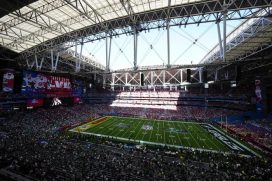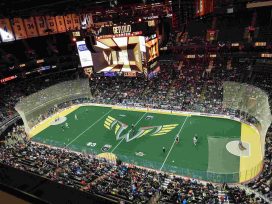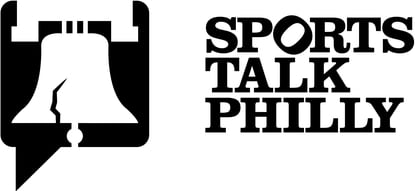For many NHL fans, a game day starts when they settle in their seats at the arena or turn on their television set (or computer stream) and ends shortly after the final horn. For a significant contingent of people credentialed to cover the team from the pressbox — those who hold full-time jobs in other fields — a gameday spans about five hours, starting with their arrival at the arena an hour or so before pregame warmups and ending when they leave the building as they pack up after the postgame media scrums in the locker rooms and the coaches' press conferences.
For those who cover a team on a full-time basis, gameday coverage begins mid-morning and ends late at night. On a typical practice day — one that does not involve breaking news or a late-afternoon announcement — it is typical to spend about five hours at the rink.
Here's a look at an average Flyers home game day — 7:05 p.m. start — from the standpoint of a member of the full-time media.
8:30 a.m.: Before leaving for the arena, it's important not only to have a handle on all work that needs to be done for the day but also to make sure that all the tools of trade — including tape recorder with working and spare batteries, laptop plug, phone charger, etc. — are on hand. It's also a good practice to keep an old-fashioned notebook and pen.
9:45 a.m.: Arrive at the Wells Fargo Center. One of the benefits of an early arrival at the arena is going through security screening quickly rather than having to wait in line later in the day. The Control Center security checks your press pass, searches and tags your computer bag and then buzzes into the building at event level.
9:50 a.m.: Set up in the media room. There is a "hidden" media room tucked away on event level at the Wells Fargo Center. The repurposed former green room, has been spruced up a lot over the last year — it used to reek of stale cigarettes and was very sparse — but now has sufficiently sized work spaces, small overhead lockers and comfortable furniture. The television set is usually tuned to NHL Network. Getting everything set up early — laptop, cell phone charger, notes, etc. — before heading to the morning skate is a bit of a time-saver in getting a jump on writing after the morning skate or jotting some pre-skate notes.
10:10 a.m.: Walk to the zamboni gate. The media generally congregates in the first few rows of seats in the stands near the zamboni gate. It is common for the Flyers starting goaltender — especially when Steve Mason is starting — to be on the ice working with goaltending coach Kim Dillabaugh well ahead of the rest of the team. Although it is common for media members to wait to see which goalie leaves the ice first at the end of the morning skate to declare which goalie is the starter, the starter can almost always be ascertained with confidence by which one defends the "home" net during the warmup. The backup stands in the net the Flyers will attack in the first and third periods.
10:30 a.m.: By this time, most or all of the Flyers players are on the ice and getting ready to take line rushes. The lines seen in the morning skate are usually the ones that will start the game together. Practice day combinations are somewhat more likely to vary from the ones that will be used in the next team. In either case, players taking "maintenance days," which has come to mean that the player is taking the morning off while dealing with a minor injury or illness but is still expected to play in the next game, can affect line combinations.
11:15 a.m.: The media is allowed to report to the Flyers locker room as soon as the first player leaves the ice. That usually happens about 45 minutes into the morning skate. The healthy scratches and rehabbing players usually remain on the ice for extra skating after everyone else exits the ice. As players return to the locker room, the media can approach whomever they need to interview. In addition to the local, out-of-town and/or national print media, it is common for some television cameras and the play-by-play announcers — often those for both teams — to make the rounds.
11:25 a.m.: Flyers head coach Dave Hakstol speaks to the media in a separate room. Until this season, the coach's interview was held within the locker room. Due to a change in NHL policy instituted after the merger with MLB.com, only NHL rights holders are allowed to bring cameras or video record interviews inside teams' locker rooms. By having Hakstol speak elsewhere, the rule is not violated. The visiting club morning skate usually begins very shortly after the ice is resurfaced following the home team skate. The visiting team coach's press conference is usually held in the hallway between the two clubs' dressing rooms. Locker room access to talk to players after the visitor's skate operates on a similar basis to the home side.
11:30 a.m. to 12:30 p.m.: Return to the media room after the home and/or visiting morning skate. The post-morning skate time is crunch time for updating or writing side-feature or "notebook" type of stories as well as gathering other materials needed for use later in the day. It is very common nowadays for even traditional newspaper to handle website blogging duties in addition to writing traditional game reports, notebooks and features that make it into print editions. This is also a good opportunity to catch up on what's going on that day elsewhere in the NHL and around hockey.
1:30 p.m.: This is usually about the time one reaches a good stopping point in work to go grab a bite for lunch. Media members who live in relatively close proximity to the arena — or are staying at a hotel in the city — may opt to go home or off to other appointments. Those who stay around all day often eat lunch onsite or in nearby restaurants. Common choices: Going up to the first floor at Wells Fargo Center for the daily lunch specials, to Xfinity Live for the $5 lunch deal or, if there is a little extra time, going to a nearby restaurant such as Criniti's. In addition to being workload and time-dependent, weather and the size of the group can influence where you go.
Mid-afternoon: Finish up any remaining pregame work, attend to personal matters and/or catch up on other hockey news. Personally, I enjoy using the afternoon hours to watch live or archived game streams and highlights. Once in a while, there's a chance to simply settle on the media room couch and vegetate for awhile.
4:50 p.m.: The Flyers head coach has another brief media availability session, usually attended only by the local beat writers/ full-timers. Things are less chaotic than during the morning so this is the time to ask any followup questions. Hakstol is usually rather guarded — polite and approachable but not given to delving too deeply into matters — in his dealings with the press. Some previous head coaches have tended to be more expansive on topics in the late afternoon session, especially after the tape recorders are turned off at the end. It all depends on the personalities and the rapport.
5:00 p.m.: As with every NHL arena, there is a buffet dinner meal available for cash purchase at the Wells Fargo Center in a room that doubles as a commissary and sometimes as a space for press conferences (primarily during the playoffs). Normally, there is a lot gathering — team employees, scouts from around the NHL, reporters, TV and radio broadcasters, PA address announcer Lou Nolan, visiting team officials, game-night photographers, anthem singer Lauren Hart, and many others — who pass in and out of the room in the time leading up to warmups.
5:30 p.m.: The elevators at Wells Fargo Center are notoriously slow and prone to breaking down. However, it is always a pleasure to be greeted by Frank, an elderly gentleman who has operated the arena elevators for many years. "Comin' out!" Frank announces in his cheerfully raspy voice. He then greets the new passengers with a smile and a friendly hello. Ask Frank how his day is going and he replies with "Oh, up and down!" Thank him upon arrival to the balcony or event floor and it's a cheery "yes, sir!" There are two elevator banks. A larger all-purpose ones with space for service carts stops on multiple floors and a smaller one for passengers only that is generally intended for balcony (press box) to event level use. Unfortunately, it has been common over the years for at least one of the elevators to be out of service at a given time. The "media" elevator has been undergoing renovation all season to date, which means that everyone has to share the service elevator.
5:33 p.m.: The press box at the Wells Fargo Center is named in memory of legendary Flyers broadcaster Gene Hart and there is a captioned photo exhibit tracing his Hall of Fame career upon arrival in the press box. As with most children who grew up in Philadelphia during the Broad Street Bullies era, I first learned about hockey through Gene Hart's broadcasts. As I walk past the Hart display in the press box upon my arrival, I always pay a brief silent tribute by touching the bottom of the central photo's caption with my right hand as I walk past the wall. It's just a little personal way of remembering that my own path to being in that space began with Gene Hart's enthusiasm for the Flyers and knowledge of the sport, as well as his love of teaching viewers about the finer points of the game.
5:35 p.m.: I've learned over the years that if there are any personal phone calls to make, the best time to do it is before the sound checks and music start up at Wells Fargo Center. Otherwise, you can hardly hear a thing once the volume gets cranked. I usually try to check on my wife and my kids' days before the commotion starts.
5:40 p.m.: The local members of the Professional Hockey Writers Association are assigned the block of seats on the lower row of press seating closer to center ice and adjacent to the broadcast booths. It is a little more spacious to sit there, especially during the regular season when there's an unassigned seat on either side. For many years before that, I sat in seat 21 on the lower right side, which is where the row of internet-based writers are generally assigned. The Flyers are arguably the NHL's most generous teams — certainly the most generous among the big-market clubs — in issuing credentials to online outlets, blogs, college newspapers, etc. If not for the Flyers' willingness to provide such widespread access, I never would have gotten my first opportunity to cover NHL games 16 seasons ago as a writer for the long-since defunct Pro Hockey Euro Report, writing feature articles on NHL players from European countries.
Pregame warmups: As a ticket-buying fan, I used to love the pregame warmups. I pay less attention nowadays and tend instead to peruse the packet of media materials placed at eve. However, every once in a while, something of interest happens. I like to see which players have certain rituals. For instance, John LeClair always finished the warmup by pulling out about a half-dozen pucks to the edge of the crease, flipping each one into the net and then carefully placing the final one on the center of the goal line before skating off the ice.
One of my favorite pregame warmup memories happened during the 1995-96 season in the final year of the Philadelphia Spectrum. The ever-competitive Ron Hextall got angrier and angrier because, for whatever reason, he could hardly stop a thing as shooter after shooter put the puck over or off his equipment into the net. Hexy hit a boiling point as Shawn Antoski and Kjell Samuelsson — two players hardly known for their goal scoring — ripped shots right past him during the shootaround. Finally, Hextall finished his warmup by snapping a puck out of the area, storming off to the bench and breaking his stick over it and then stalking up the tunnel. He then went out and played a strong game in a win over the Ottawa Senators.
7:05 p.m. to about 9:40 p.m.: Game time at last! Over the last couple seasons, I have periodically been asked to make the game's three-star selection; something I regard as a huge honor. The list has to be submitted (with instructions on how to modify it based on different outcomes) with about five minutes left in the third period. That is why it is common for the three stars in overtime games or shootouts to consist of the game-winning goal scorer (even if he otherwise had a quiet game), the winning goaltender and a third player who had a strong overall game. The media also submits a list of players to interview in the locker room.
9:45 p.m.: Teams are required to open the locker rooms within five minutes of the end of the game. The room is often empty when the doors are opened, and then members of the PR staff bring in the requested players one at a time. In days gone by, the doors were simply opened and the media approached whomever they wanted. The coach's postgame press conference is held in a separate room adjacent to the lounge where players' families and guests congregate after the game. On an average night, the postgame scrums take about 15 minutes. A tip to aspiring writers: The post-game locker room is inevitably crowded and very loud. Also keep in mind that beat reporters are on deadline and TV reporters are doing live interviews and collecting soundbites. If you are working on a feature story, it is much better to do the interview on a practice day in Voorhees rather than trying to do it after a game.
10:00 p.m. to 12:30 a.m. (or later): Reporters on newspaper deadlines scramble to submit copy. Those who are doing multiple stories, or those such as myself with more fluid deadlines but who try to post something the same night as a game, often stay until close to midnight or even later in some cases.
Bill Meltzer is a columnist for Flyerdelphia. Follow him on Twitter @billmeltzer.







